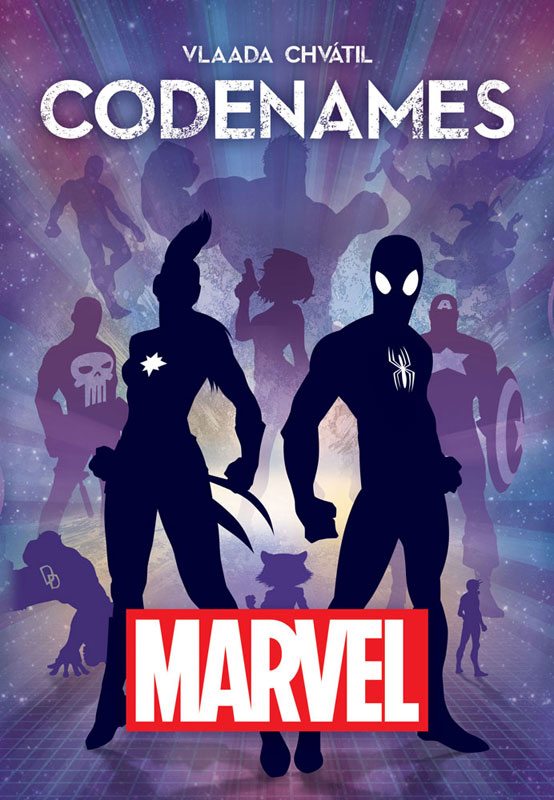One of our favorite games is now available in a marvelous new flavor: Codenames: Marvel.
What Is Codenames: Marvel?
Codenames: Marvel is a competitive game for 2 to 8+ players, ages 9 and up, and takes about 15 minutes to play. (The game is for two teams, so ideally you want 4 or more players, but there are variant rules for 2 and 3 players.) It retails for $24.95 and is available now in stores and online.
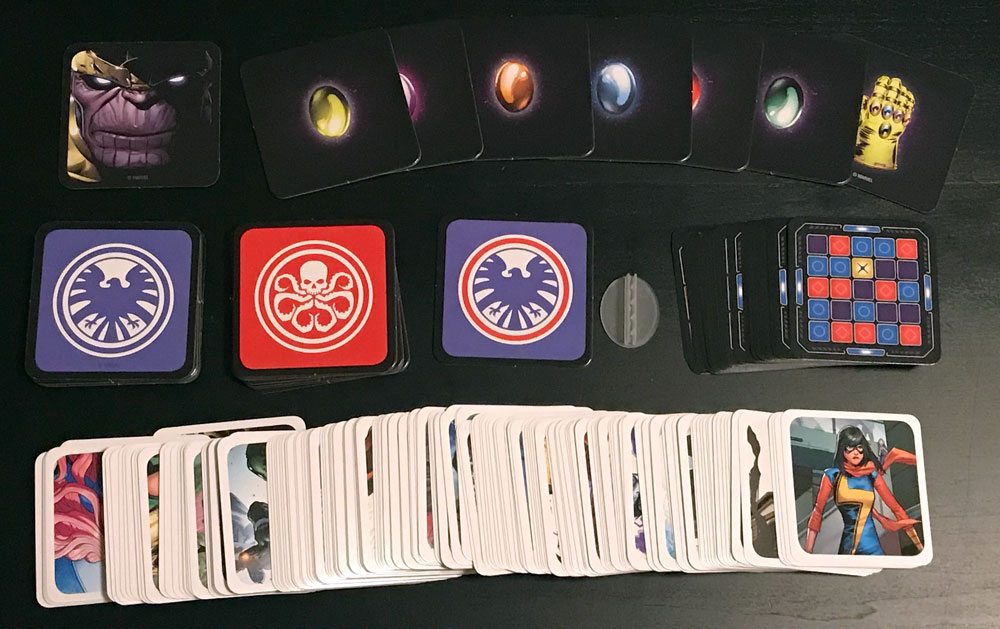
Codenames: Marvel Components
- 200 Asset Cards
- 40 Key Cards
- 25 Cover Cards (8 S.H.I.E.L.D., 8 HYDRA, 7 Neutral, 1 Double Agent, 1 Thanos Assassin)
- 1 Card Stand
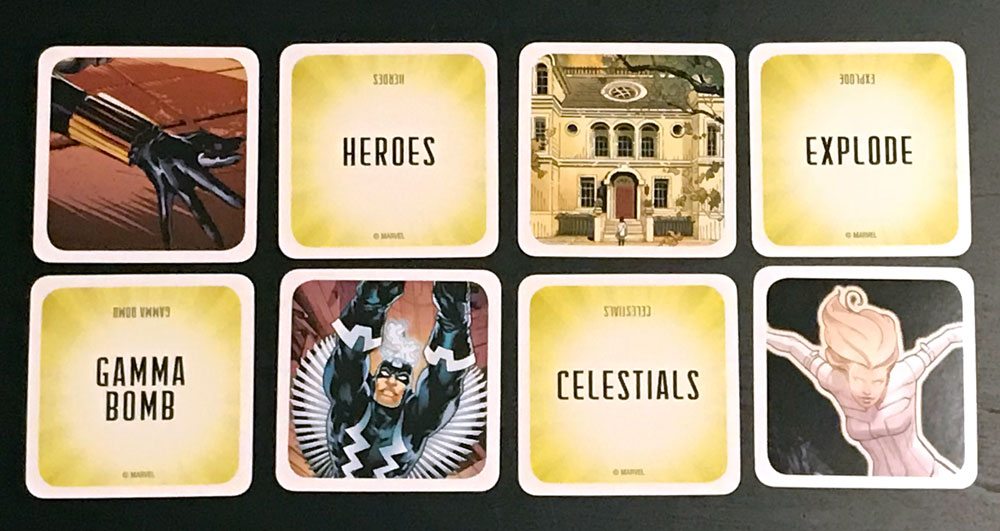
The components in this edition are similar to Codenames Pictures, with square cards and covers. However, the asset cards have images on one side and corresponding words on the other, all taken from the Marvel universe. The assets include characters, objects, vehicles, and more—it’s a treasure trove for Marvel geeks, but a lot of the cards will certainly be unrecognizable to those who (like me) mostly know the Marvel cinematic universe and not much more. But it’s okay—you’ll see. I recommend giving these cards a really good shuffle before the first game, because a lot of similar and related cards are adjacent to each other when the game is first opened.
As with the original version, the word side of the asset cards includes the word very large facing one direction, and then a smaller copy of the word upside-down so that the clue-giver can read them. And, like the original version, you’ll find yourself just looking at the larger version of the word upside-down when you’re giving clues, because the one facing you is s0 tiny. In addition, each card now has “©Marvel” at the bottom on the word side, only slightly smaller than the small asset name, making it more confusing.

The key cards show a 5×5 grid, with each space colored red, blue, black, or yellow. In addition, each card also has either red or blue bars along the borders. These are very similar to the original game’s key cards, with some new design elements.
The cover cards are S.H.I.E.L.D. (blue) and HYDRA (red), and the neutral cards (“bystanders” in the standard game) are now 6 Infinity Gems and a completed Infinity Gauntlet, and Thanos is the assassin. The double agent card has S.H.I.E.L.D. on one side and HYDRA on the other, along with a colored circle that helps you separate it from the rest of the cover cards.
How to Play Codenames: Marvel
The gameplay remains the same as the original edition, so if you’re already familiar with Codenames you can skip to the next section. I’ll just give a brief run-down here of how the game works.
The Goal
The goal of the game is to identify all of your assets before the other team does.
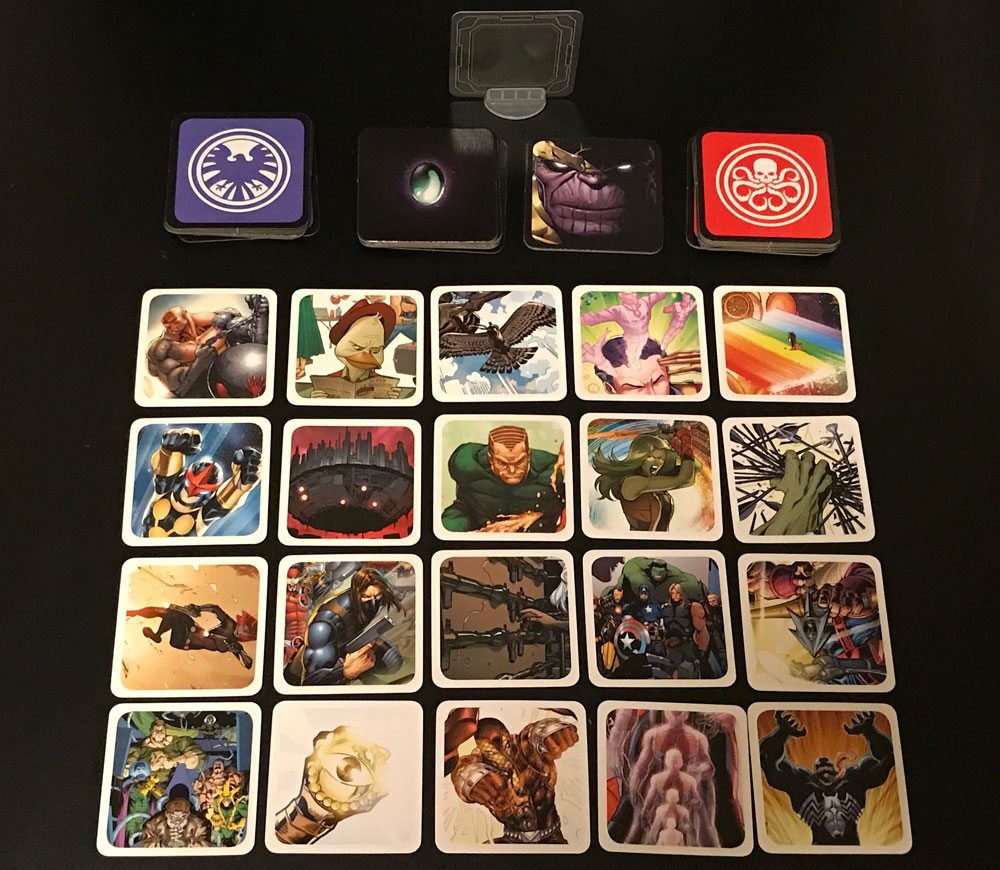
Setup
Split up into two teams; each team will need to have one director (clue-giver) and the rest of the players are agents (guessers). The directors sit together on one side of the table, and everyone else sits across from them.
Shuffle the asset cards and lay out a 5×5 grid. You can choose whether to use the pictures, the words, or a mixture of both, but the cards should be oriented toward the agents.
Draw a random key card and place it on the stand so that only the directors can see it. Each team takes its stack of cover cards, with the neutral covers and assassin placed nearby. The team whose color appears in the color bars on the key card will go first, and they also take the double agent cover card and flip it to show their team. (Note: the starting team has 9 assets to find, and the other team has 8 assets.)
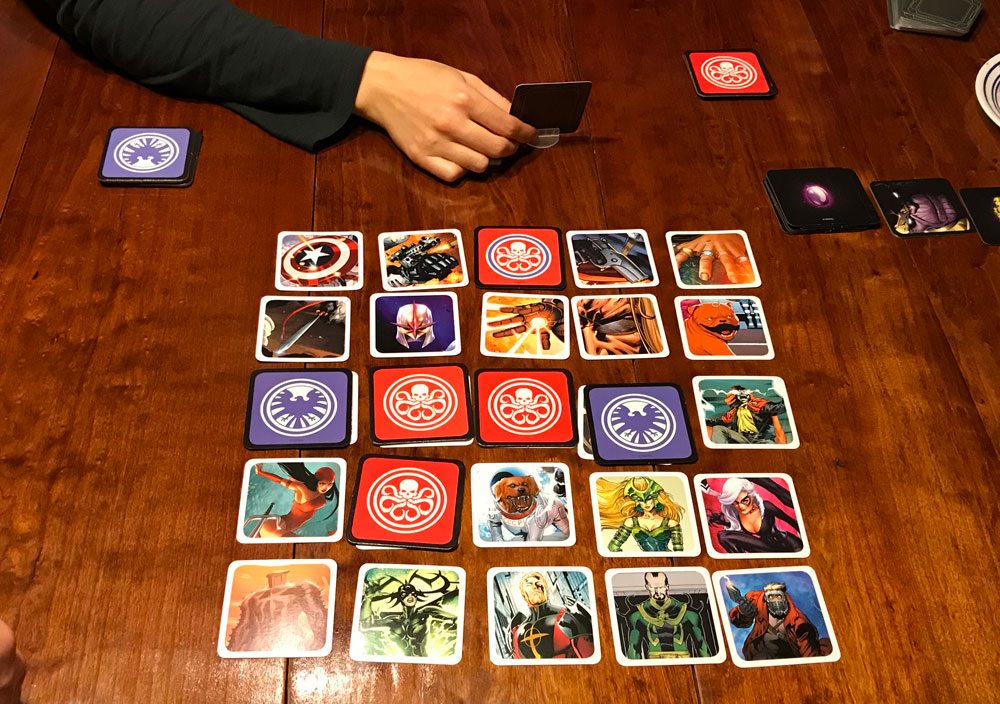
Gameplay
The two teams take turns playing. During a turn, the director must give a one-word clue followed by a number, indicating the number of the team’s assets that match that clue. Then the agents may discuss their guesses, finalizing their guesses by touching the asset cards one at a time and waiting for the directors to confirm. If the card touched belongs to the guessing team, the director places their own cover card on it, and the team may continue guessing. If the card touched belongs to the other team or is a neutral card, the corresponding cover card is placed on it and the turn ends. If the card touched is the assassin, then Thanos arrives and the other team wins immediately.
Note that the directors are supposed to keep a straight face and provide no information whatsoever aside from the single word and number. The rules even suggest that the guessers do not make eye contact with the directors.
The number of guesses a team is allowed to take is one more than the number given by the director. So if the director said “green 2,” the team could take up to 3 guesses, as long as the first two are both correct. This comes into play later in the game, when agents have missed guesses on previous turns—they can use these extra guesses to catch up on old clues as well.
There are a few advanced clue rules that can be introduced as well. “Clue: Unlimited” allows the team to make as many guesses as they want (as usual, they must stop if they make an incorrect guess). It can be helpful for making up lost ground when the team has gotten many incorrect guesses in previous turns. “Clue: Zero” is an opposite clue—it also allows the team to make unlimited guesses, but means that the team’s cards are not related to the clue. For instance, “Animal: Zero” means that any cards pertaining to animals are not supposed to be guessed.
Game End
If you cover up all of your assets first, you win the game!
2-Player Variant
For two players, you both play on the same team, with one player as director and one as agent. After each turn, the director places one of the opposing covers on a card. To win, you must cover all of your assets before all of the opposing assets are covered—your score is based on how many opposing covers are left when you finish.
3-Player Variant
Two players serve as directors, and the third player is an agent for both teams, guessing as well as they can for all the clues. The director who covers their assets first wins.
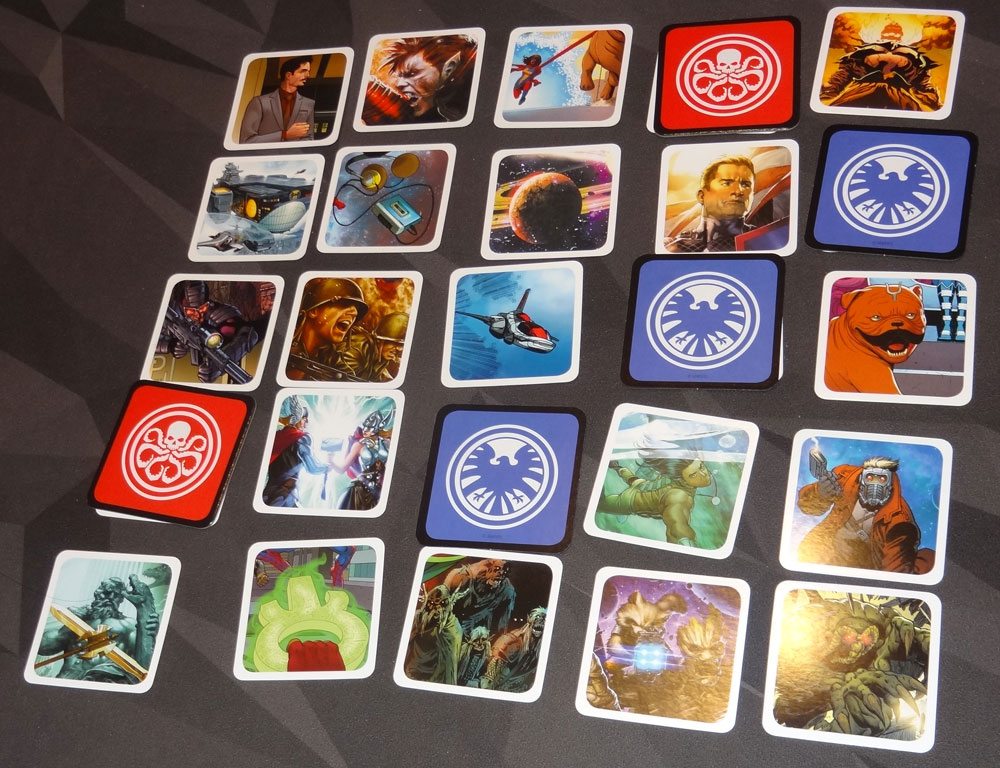
What’s New in Codenames: Marvel
If you’re already familiar with Codenames, you won’t have any trouble playing Codenames: Marvel. The terminology is slightly different: codename cards are now called assets, spymasters are called directors, and the guessers are called agents. Bystanders have become neutral cards.
Marvel Experts Variant
If you’re playing with Marvel experts, you can play a variant in which directors cannot give clues that include the name of the asset shown in a picture—so if you saw a picture of Iron Man, you couldn’t use the word “iron” or “man” in your clue.
Of course, playing with the word side of the cards will present a bigger challenge, too.

Infinity Gauntlet Variant
When a neutral card is covered, use the gem cards first. When the last neutral card is covered, use the Infinity Gauntlet cover card—Thanos now has the gauntlet, and the other team wins, just as if you had picked the assassin card.
Why You Should Play Codenames: Marvel
When I first saw a copy of Codenames: Marvel at Gen Con this summer, I realized how little I knew about Marvel outside of the most familiar characters. Sure, I could recognize Spider-Man and the Avengers and even Lockjaw … but who’s this blue-faced guy with the pointy ears? (Malekith, as it turns out.) When I picked a random handful of cards, I recognized fewer than half of them.
So should a Marvel novice play Codenames: Marvel? Well, even if you don’t know the characters pictured on the cards, you can still give clues about them. You might be able to connect some cards based on colors, poses, weapons, or other attributes. In that sense, it could basically be another version of Codenames Pictures, but with much more elaborate artwork. When another Marvel-newbie friend gave the clue “tiki,” I could tell she meant the picture of M.O.D.O.K. even though the resident Marvel expert was rolling his eyes, because, hey, he kind of does look like a tiki.
That said, if you have some true Marvel nerds among you, it is also an absolute blast to play (or just watch) Codenames: Marvel with people who know their stuff. They’ll be able to look at the cards and tell you not only who a character is, but probably who drew that version of it and how the costume has changed in later iterations. (I highly recommend divvying up the Marvel nerds between the two teams just to balance things out a little.)
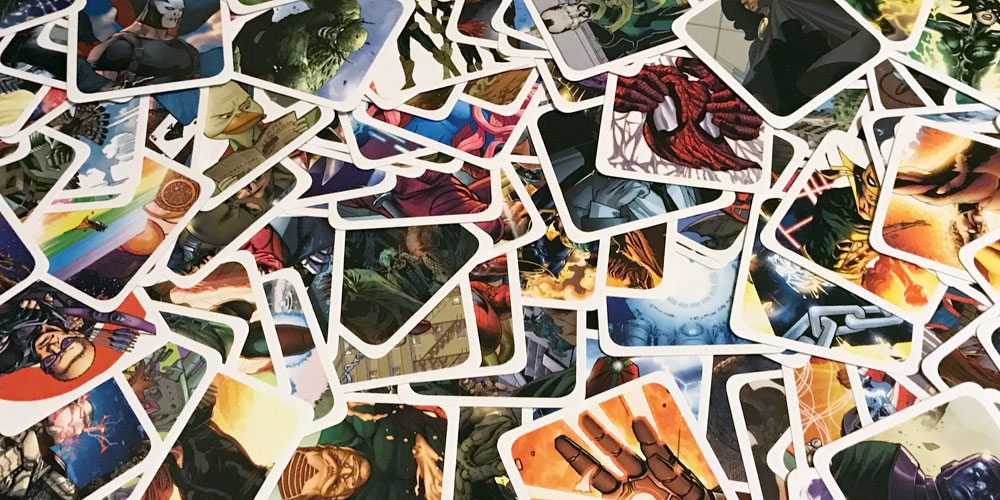
And you can certainly play with a mix of Marvel geeks and non-geeks: it can be particularly challenging when the geeks are directors and the non-geeks are agents, because giving a clue that makes sense to somebody who doesn’t recognize the characters themselves takes some extra creativity and observation.
The Infinity Gauntlet variant rule is the only significant rule difference in this version, but you might as well include it—it just adds another small twist to the game, and I like that the neutral covers have become the gems and gauntlet.
Overall, I think Codenames: Marvel is a very fun twist on the game. While it can be played with Marvel experts and novices alike, it’s the die-hard comic book geeks who will get the most out of this particular version. On the other hand, I suppose you could also use it as a set of educational flashcards to learn more about the Marvel universe.
Stay tuned for a closer look at Codenames: Disney Family Edition soon!
Click here to see all our tabletop game reviews.
If you’d like to stay up-to-date with all of our tabletop gaming coverage, please copy this link and add it to your RSS reader.
Disclosure: GeekDad received a copy of this game for review purposes.

